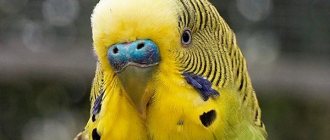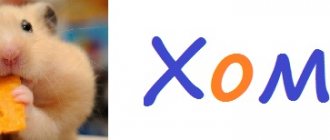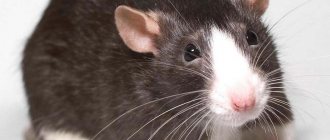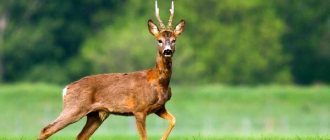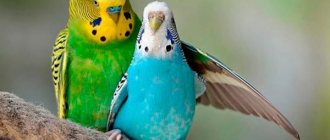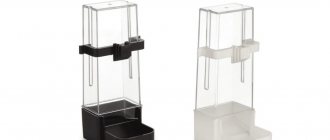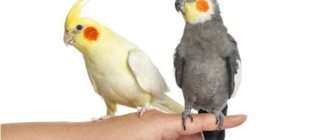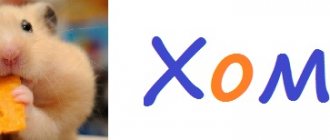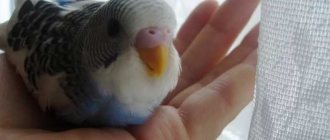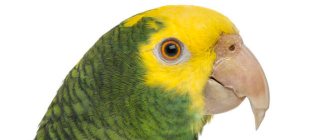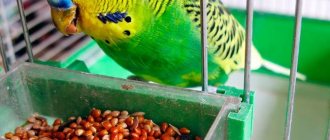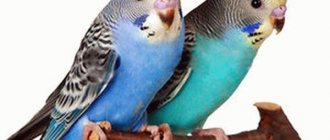Budgerigars become independent early. At the age of 1-1.5 months, the chicks already fly well and are able to feed without the help of their parents. Young birds rarely get sick, easily adapt to a new environment and quickly get used to people. At 10-12 months, birds reach sexual maturity, after which they are considered adults.
In order for the parrot to quickly take root and please the household for many years, it is better to choose “young animals”. To do this, it is important to know how to correctly determine age by external signs. The ability to distinguish a young bird from an adult bird will help you avoid mistakes or deception on the part of dishonest sellers.
Lifespan
The average lifespan of domestic budgerigars is 8-10 years. In favorable conditions and with proper care, they can live 12-15 years. There are often long-livers whose age has reached 20 years or more.
The lifespan of birds is positively influenced by the following factors:
- nutritious, balanced diet;
- regular feeding with mineral mixtures;
- quality drinking water;
- maintaining hygiene;
- a spacious, clean cage in a warm room that is periodically ventilated;
- proper lighting;
- systematic walks (it is advisable for the parrot to fly out of the cage every day);
- regular examination and timely treatment;
- frequent contact with the pet and friendly communication.
Parrots are sensitive and vulnerable birds. They pick up on a person’s negative emotions and have a hard time withstanding aggression and shouting. Stress can cause them illness and even death. Therefore, it is very important to show them kindness and care. In a friendly environment, parrots are active and sociable. They easily make contact, quickly learn to speak and willingly reproduce when there is a pair.
In the wild, budgerigars live 3-5 years. They often die from lack of food or become prey to predators. It is thanks to the creation of favorable conditions that domestic birds live much longer than their wild counterparts.
Methods for determining age
With the onset of maturity, the appearance of parrots remains almost unchanged. Therefore, the younger the bird, the easier it is to determine its age. The first molt takes place from 3 to 5-6 months (it is called juvenile). Before it begins, the chick has pronounced differences from the young and adult individuals.
There are a number of distinctive signs by which you can determine how young a bird is.
Voskovica
Parrots have an area above their beak called the cere. As the first months of life progress, its color changes, making it possible to determine the age of the chick and its gender.
How the color of the cere changes:
- Females . From birth to 2.5-3 months, the beak is soft purple, pale pink or blue. There are white or light-colored circles around the nostrils. As the wax grows older, it turns brown or beige. The nostrils retain a white edging.
- Males . Barely fledged chicks have a bluish or light purple cere (sometimes pink). There are no circles around the nostrils or they are barely visible. During the first molt, the color of the beak changes and becomes bright blue.
This method of determining age is excellent for most species, except for certain mutation breeds (including albinos and lutinos).
Eyes
In chicks, the eyes remain black until 5-6 months. As you grow older, white irises begin to appear around your eyes. In some species it occurs at 10-12 months.
It is impossible to determine the age of a young parrot from the eyes with an accuracy of up to a month. If there are no circles around the eyes, the bird is definitely less than 1 year old. This method should be used as an auxiliary factor.
Beak
An adult parrot has a uniform yellow beak, sometimes with a greenish tint. Chicks are born with a black beak or have black spots or dark stains on it.
Only very young individuals can be distinguished by this feature. Often the beak becomes yellow already at 2-3 months, when the bird is still young.
Sometimes sellers resort to tricks and tint the surface of the beak of an older individual. Therefore, it is important to examine the parrot comprehensively, and not to determine the bird’s age by one indicator.
Plumage
In chicks, a wavy pattern covers the entire head. “Waves” start from the very eyes and reach the neck. During molting, the waviness gradually disappears, and by 8-10 months the head becomes smooth.
Up to 1.5 months, the youngsters have sparse plumage and dull colors. The contrast is especially visible when there are adult birds nearby. But by 2 months the feathers become thick and fluffy, evenly and tightly adjacent to each other. A plain “cap” on the head indicates that the juvenile moult has already passed.
Paws
The paws of young individuals have smooth, smooth skin. The presence of dense scales can be seen at close range. The same cannot be said about the skin of adult birds. With age, the scales become pronounced, the skin loses its smooth structure and becomes noticeably rougher.
If the paws are covered with bumps and growths, then the bird may be sick.
Tail
The younger the bird, the shorter its tail. Feathers in this area grow more slowly than on the body. A parrot can acquire its final tail length either at 3 months or at one year of age.
A bird’s tail can be trimmed to visually “rejuvenate” it. Also, tail feathers sometimes fall out as a result of disease (or they are plucked by the bird itself). These factors must be taken into account during the inspection.
Differences in characteristics between males and females
When choosing a parrot, it is advisable to take into account its gender, and this is especially important if you plan to buy a pair and breed birds in the future. Knowing the gender, it is much easier to determine the age of the bird.
These features include:
- in small females, the thickening above the beak has a pink, blue or purple tint;
- in adult girls, the cere becomes darker and also acquires a brown color;
- Boy parrots have a light purple wax color;
- in older boys, the upper part of the beak has a dark purple tint.
If you plan to buy pure or variegated budgies, then they retain the same wax color at any age, so this method is not suitable for determining age.
Young male Young female Adult male Adult female
The average lifespan of a parrot is 10 years . 5-year-old birds are practically no different from 10-year-old birds. It is easiest to determine the age only in the first year of a bird’s life. It is important to know about the main characteristics of the young in order to select a chick, since it is easy to accustom it and teach it to speak.
Question: How old is a parrot by human standards? Answer: 1 year of a parrot's life is equal to approximately 7 years of a human life.
Other signs
Most species of parrots have spots on their throats that are commonly called “beads.” When young they are dark in color with blurred edges. As the bird matures, the spots become black with a clear outline.
When a parrot reaches 1 year of age, its size from head to tip of tail is on average 18-20 cm. Young parrots look smaller even upon visual inspection. This indicator should not be regarded as the main one. Since there are certain types of wavy rocks that are small in size.
Ornithologists and experienced breeders say that the best way to avoid errors in determining age is to look at a bird in all respects, and not just by one (for example, only by the color of the wax or by the eyes). There are more than 200 varieties of budgies, and each of them has its own characteristics.
Chicks at the age of 1-1.5 months already know how to navigate in space and fly well. Therefore, if a parrot moves uncertainly, this is evidence of its illness, not its youth.
Advantages of buying from a breeder
Professional parrot breeders sell their pets ringed. The ring on their foot indicates the date of birth of the chick and the country or nursery where these birds are sold. Sometimes the number of the chick is also indicated. The ring is put on by a nine-day-old bird. This is a kind of parrot passport that dispels doubts about its age.
But even here you can be deceived! Make sure that the ring is solid and non-removable. And it didn’t look as if it had been pinched yesterday on the leg of an adult bird with forceps, and today it was being sold to you as a young bird.
Development by months
In the first months after birth, the appearance of budgerigars changes noticeably. Using the table, you can quickly study the changes taking place:
| Age of budgerigar | Cerise color ( male (1), female (2)) | Eyes | Beak | Drawing on the head |
| Up to 1.5 months | 1) pale pink or purple 2) blue or pink, circles around the nostrils | Eyes completely black | Beak black (some with a black tip) | The wavy pattern of plumage begins from the cere |
| 1.5-3 months. | 1) blue or purple 2) pink or light brown, circles around the nostrils | Eyes completely black | The beak begins to turn yellow, black spots remain | Wavy plumage starts from the cere |
| 3-4 months | 1) blue or dark lilac 2) brown or beige | Eyes completely black | The beak is yellow (sometimes with a green tint) | The first molt, during which the area from the cere becomes smooth |
| 5-8 months | 1) bright blue or purple 2) brown or beige | A white (or light) iris begins to appear around the black eyes | Yellow beak | The waviness “recedes” to the crown, a smooth “cap” is formed on the head |
| Over 8 months | After 8 months wax color does not change | The white edging around the black eyes acquires clear contours | Yellow beak | The hat is smooth, one-color, wavy pattern starts from the neck |
Most varieties of budgerigars already have a fully formed appearance by the age of 8 months, which remains unchanged in subsequent years.
From reputable breeders, each pet has a personal ring. It is put on on the 9th day after the birth of the chick. The ring displays the main information about the parrot and its breed. When purchasing, it is important to make sure that the hoop is solid, without any signs of tampering.
An exception
There are individuals whose age can be determined by external signs even for an experienced poultry farmer. These include:
- Lutino parrots;
- Albinos;
- Clean parrots;
- Repressively variegated.
The first ones have red eyes, which remain with them throughout their lives. And the latter have a cere that does not change throughout life. With rare exceptions, this part of the beak of females becomes somewhat darker.
Light “mutants” are generally devoid of all pigmentation characteristics, which is why it is difficult to determine their age. Black pigments are often lost, without which the wavy does not look like itself. However, there are still parameters regarding the size of the body and the skin of the paws. The latter is often more correct, because it does not depend in any way on the plumage.
Exceptions
Varieties of budgerigars are divided into 2 large groups. Group 1 includes all types of birds with normal waviness (different colors have their own subgroups). Group 2 includes breeds of parrots that were subject to various mutations and did not retain the wavy pattern. These include the following types:
- birds with opaline color;
- pieds;
- albinos;
- lutinos;
- lacewings;
- harlequins and others.
Parrots of mutation breeds have their own characteristics, so determining their age can be more difficult. Each type has its own characteristic features, namely:
- the wavy pattern on the head is almost always absent; the “cap” adorns the head of both juveniles and adults;
- eyes remain black from birth until old age;
- Lutinos and albinos have red eyes throughout their lives;
- the beak is yellow at birth, or the black color disappears during the first 3-4 weeks of life;
- the cere changes color in the first months only in females (its colors are the same as in ordinary wavy breeds), and males at any age retain the beak pink, white or blue.
Therefore, in recessively variegated and pure parrots, age is determined by the following indicators:
- tail length;
- size of the individual;
- condition of the skin on the paws;
- density and structure of plumage.
Non-standard cases also occur among birds from group 1 with normal undulation. There are chicks that were born with an iris around the eyes or with a bright blue cere. In order not to make a mistake, it is important to consider the parrot according to all the main parameters.
How long do budgies live?
By remembering how to determine the age of a budgie, you can choose the perfect pet for yourself. How many years will he live with you? Small birds do not live very long - on average 10 years. Provided that you provide them with good care, varied and nutritious food, regular walks outside the cage and your love and attention.
Unfortunately, you can find out the age of a budgerigar by all these signs only from chicks six months old. In older birds the signs become less noticeable. Birds older than one year are no longer much different from their more mature counterparts. Unless sick and old birds become clearly distinguishable against the background of their fellow birds.
Watch in this video the development of budgerigars from birth to adulthood, how age is determined at each stage:
Signs of an older bird
If a parrot at the age of 8-10 months can be easily confused with an individual that is already 3-5 years old, then you can recognize an old bird.
Signs of an elderly bird:
- over the years, the plumage around the eyes disappears;
- the pupil is cloudy, often with a whitish spot in the middle;
- the plumage loses its rich color, becomes dull, and bald patches appear in places;
- the tail has bald spots (sometimes there are no feathers at all).
Behavior also reveals old age. “Old people” are not so active and inquisitive, they move little, they prefer to sit, occasionally flying to the next perch.
Age of a parrot by human standards
Among other species from the Parrot family, budgerigars cannot be called long-livers. There are many breeds whose representatives live for decades. But when compared with human life, wavy individuals live to a ripe old age.
The age ratio between humans and parrots is presented in the table:
| Budgerigar | Human |
| 1 month | 7 months |
| 3 months | 1 year 9 months |
| 6 months | 3 years 6 months |
| 9 months | 5 years 3 months |
| 1 year | 7 years |
| 2 years | 14 years |
| 3 years | 21 years old |
| 4 years | 28 years |
| 5 years | 35 years |
| 6 years | 42 years |
| 7 years | 49 years old |
| 8 years | 56 years old |
| 9 years | 63 years old |
| 10 years | 70 years old |
| 11 years | 77 years old |
| 12 years | 84 years old |
| 13 years | 91 years old |
| 14 years | 98 years old |
| 15 years | 105 years |
The peculiarity of budgerigars is to maintain their appearance and beauty throughout their lives. They are energetic and curious, sociable and often talkative. Pet birds can become true friends in the home.
In order for a parrot to please its owners with its company for as long as possible, it is better to acquire it at a young age. To do this, it is important to study all the distinctive characteristics. Armed with knowledge, you can safely go in search of your future pet.
Results
When choosing a budgie, it is advisable to take into account some signs that allow you to determine the sex and age of the bird. This is relevant if a bird is selected for subsequent breeding or for learning to speak.
You can get the necessary information yourself to avoid being deceived by careless sellers. To do this, the coloring, condition of the plumage and other external parameters of each bird are taken into account.
If you cannot determine gender and age, then it is advisable to contact only professional and well-known breeders.
